No matter how well-aligned our optics are, it won’t help if the air or optics in our telescope are warping the light rays. Collimation’s twin and frequently overlooked factor in achieving sharp telescope views is the thermal equilibrium, or cooldown, of both the telescope tube and its optics.
When a telescope is moved from a warmer environment to a colder one (like taking it outside on a chilly night from a warm house), the temperature difference can cause the metal of the tube to contract and the glass/mirror to change shape slightly. Both of these factors can turn the image into a murky mess.
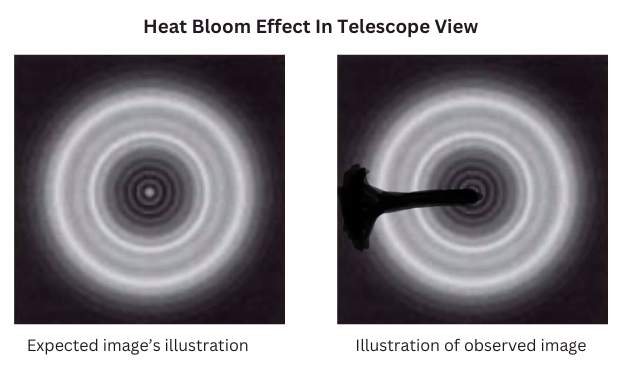
Every telescope, regardless of its design, is a balance of trade-offs, and thermals are just one of these trade-offs.
Impact of Air Currents Inside The Optical Tube
Differential cooling can lead to what’s termed “tube currents”—warm air rising and cooler air sinking inside the telescope tube, causing turbulent air that blurs the telescope image.
The primary source of these currents is our telescope’s primary mirror itself, which is radiating heat, which happens to also be straight into the optical path.
Tube currents don’t typically happen with refractors because their thick piece of glass is located at the front of the tube, where it radiates heat outward rather than into the optical path.
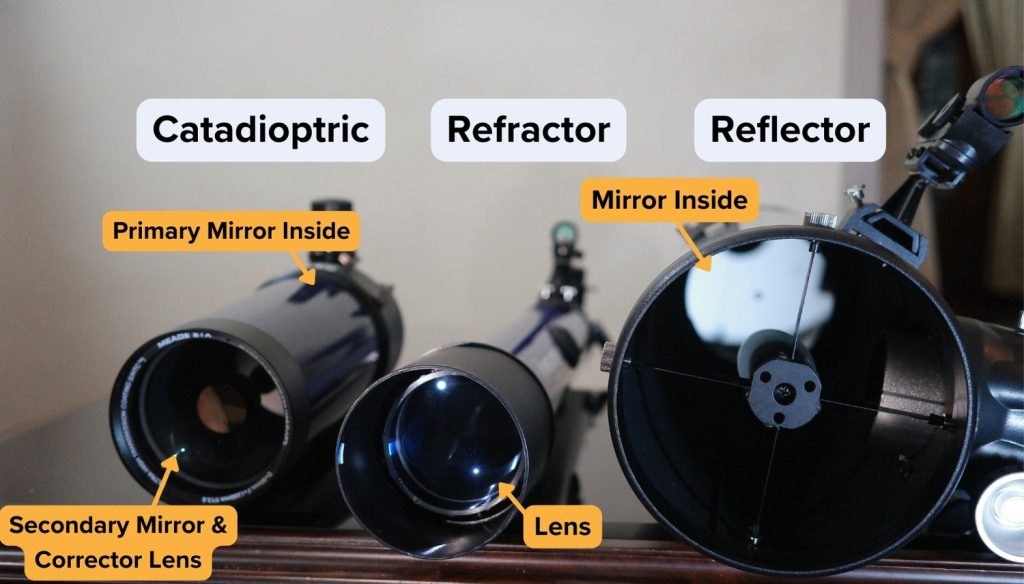
However, they are a common problem with many Newtonian reflectors and ubiquitous with catadioptrics. In these designs, light goes down the tube and then back up again, traveling through turbulent air twice—making it an even more obvious and problematic issue.
These air currents inside our tube can manifest as wavy or swirling patterns at the eyepiece, almost like looking through moving water. The view is wavy or fuzzy, with sometimes a complete inability to focus. It’s a clear indication of the thermal issues at play and a sign that steps might need to be taken to stabilize the instrument’s temperature.
Uneven Cooling: The Hidden Cause of Spherical Aberration & Astigmatism
Tube currents aren’t the only thermal problem plaguing our telescopes. When we move a telescope from a warmer indoor setting to the cooler outdoors (or vice versa), its optics may not cool uniformly. This uneven cooling can induce optical aberrations.
Two of the most common distortions I’ve noticed from this are spherical aberration and astigmatism, both of which result in a view that lacks sharpness or a clear point of focus.
- Spherical Aberration
The spherical aberration during cooldown is caused primarily by the way that most optics are shaped.
In Newtonian Reflectors:
The primary mirror of a Newtonian reflector has a dish-shaped curve ground into it, which means that in profile, the edges are thicker than the center. This means that the edge expands more than the center, and thus the mirror’s focal point changes more as we get closer to the edge. Hence, spherical aberration.
In Refractors:
The dome-shaped objective lens of a refractor (often comprised of many curved surfaces within) does the same thing. Additionally, the multiple pieces of glass in the objective of even a simple doublet refractor expand and contract at different rates too.
In Catadioptrics:
The conical or dome-shaped primary mirrors of many catadioptric telescopes lead to a more consistent thickness and thus fewer issues with expansion/contraction (though lighter weight and less material use are the main reasons for making these optics as such). The meniscus curve of a Maksutov corrector is constant in thickness too. Unfortunately, these telescopes have plenty of issues dealing with tube currents, so this advantage of uniform mirror thickness is rarely demonstrable.
That said, the new thin meniscus primary mirrors often used in large Newtonian telescopes also have constant thickness and thus little change in shape if ventilated properly. This unique property, combined with their wafer-thin profiles, leads to rapid if not instant cooldown time, even for very large 20- to 40-inch diameter mirrors!
- Astigmatism
Astigmatism, where stars appear blurry, oval-shaped or the objective has different points of focus during cooldown, is often caused by bad annealing or strain in your telescope’s optics. This is usually inherent in the glass itself, and there’s little we can do about it. I’ve also seen difference in cooling due to the different air temperatures, wind, or amount of sunlight hitting different parts of the telescope/optic.
If the astigmatism is especially bad or persists for a very long time, it may be caused by a slight pinching of your primary mirror or lens. Loosen the retaining clips or ring a bit, and it might help. However, the best solution is to just wait.
Factors Affecting Cooldown Time: Mirror Thickness, Material & Ventilation
The thickness of the primary optics in a telescope plays a pivotal role in its cooldown time. Thicker mirrors and lenses retain more heat, which translates to longer cooldown times.
Furthermore, the material of the mirror affects its rate of thermal expansion and contraction. Materials like ceramics or low-expansion borosilicate glasses (Pyrex) stabilize faster than BK7 or plate glass commonly used for mirrors. The crown glass—often used in refractors—has exceptionally bad expansion properties, but this is usually offset by placing the most thermally problematic lens element at the front. The thick Maksutov corrector lenses are usually fairly low-expansion, thankfully.
While waiting for a telescope to reach thermal equilibrium, I’d advise you to set sights on less demanding objects in the sky. Broad, diffuse objects such as larger nebulae or star clusters can still deliver satisfying views even when the telescope’s optics aren’t perfectly cooled. Using lower magnifications during this cooldown phase further ensures a more pleasing and less distorted view.
Fans and insulation can improve the cooldown of reflecting and catadioptric telescopes. Dedicated fans for inside Cassegrain telescopes and various dedicated fans for Newtonians are available (many are based on PC fans).
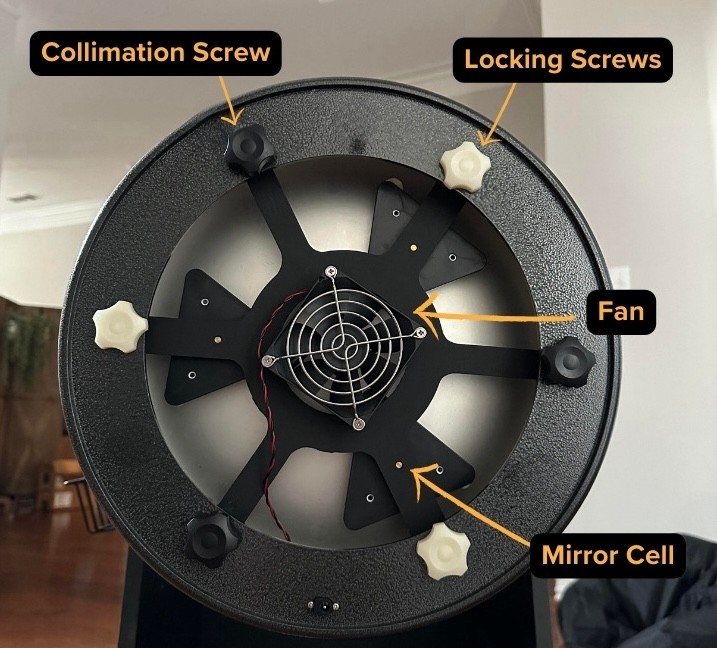
It’s essential to use Sorbothane or another rubbery, vibration-absorbent material to prevent the fans from jostling your telescope; springs or wires to suspend the fans behind the scope will also do.
Importance of Ventilation in Cooling Down Telescopes
In the case of a telescope mirror or lens, even minute changes in shape due to temperature fluctuations can impact image quality. So it’s important to allow hot air to ventilate out of the telescope, avoiding trapped turbulent layers or uneven cooling of the optics.
In Refractors:
With refractors, there’s little we can really do to improve ventilation.
The dew shield is essential for blocking glare, and if we use any fans, it would just serve as dew magnets or cause more distortion than they remove. Really large (10” and up) refractors can get heavy and/or suffer from thermal problems from their enormous tubes. I even know some people who’ve cut holes in those tubes like Swiss cheese or a machine gun barrel, but if you own a refractor that size, you probably do not need to read this article of mine.
Most refractors cool down to ambient temperature in less than 30 minutes on their own; the largest triplets can take an hour at most.
In Reflectors & Catadioptrics:
For the rest of this section, I’ll deal with the ventilation of reflectors and catadioptrics, which place a primary mirror at the back end.
The design and construction of the mirror cell—the apparatus that holds the primary mirror in a reflecting or catadioptric telescope—contribute significantly to how well the mirror cools down as well as to alleviating tube currents. A well-designed mirror cell provides ample ventilation and facilitates even cooling, whereas a poorly ventilated one can trap heat. Sadly, the cell at the back of the majority of catadioptrics I’ve seen does just that; a poor ventilation.
A well-designed mirror cell also allows plenty of air around the primary mirror to alleviate tube currents. But I see most commercial telescopes failing at this, since they keep as little a gap as possible between the tube and mirror to minimize size/volume and thus weight/cost.
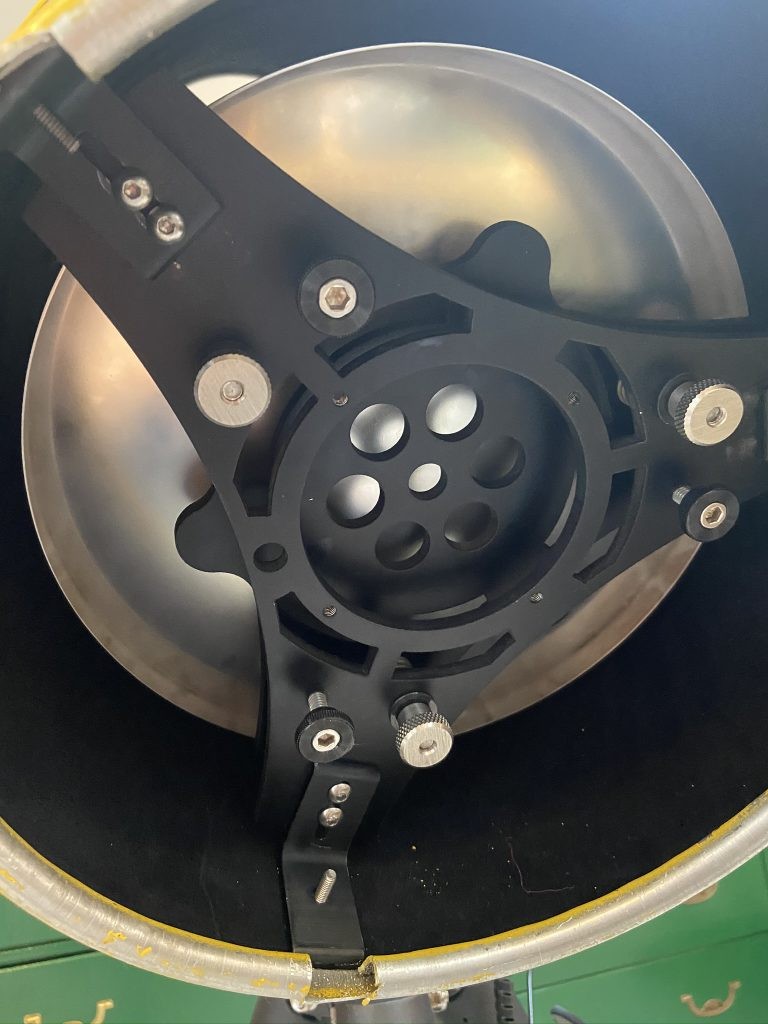
A mirror cell usually benefits from a fan (or two, or three) at the back if there is an exposed portion of the mirror or at least a hole. I’d advise a 80mm fan for 14” and smaller scopes. A 120mm fan is fine for bigger ones. Try to center the fan(s) on the mirror.
In some thin-walled tubes or in many truss telescopes’ mirror boxes, a boundary layer of stagnant air can form around the mirror. This layer acts as an insulating blanket, slowing the mirror’s cooldown. I’ve found sideways fans to be effective in disrupting these layers, ensuring uniform cooling, though a vent has to be added on the opposite side to let it blow out.
Ed Allen has developed an excellent forced-air ventilation system for larger reflecting telescopes, which has been implemented by another fellow telescope maker, Howard Banich. This system is, quite frankly, overkill for most people, but it will keep your optics cleaner as well as optimized thermally. It’s ideal for preserving the fragile and short-lived spray silver coatings on telescopes like Howard’s 30”.
Insulating The Telescope
In my experience, some telescopes just have inherently problematic thermal properties—those that, no matter what we do, seem to resist stable, even cooling. In such cases, especially in climates where the outdoor temperature and/or dew point remain close to the indoor room temperature, it might be beneficial to effectively insulate the tube to restrict any remaining ventilation and keep the telescope indoors, or outside in the garage if it’s cold and dry. By maintaining the telescope in a “pre-cooled” state, one might mitigate some of the more common thermal issues.
I’ve even seen people wrap their telescopes in reflective insulation, which has a similar stabilization effect and helps to ward off dew in tropical environments.
Dew Effects in Optics
While it might seem that rapidly cooling a telescope is the ideal solution to these thermal issues, cooling it too well would attract condensation. If your tube has dew or frost forming on it, great! You probably don’t have much in the way of tube currents to worry about! However, it’s also a warning sign that there is potential for dew and frost to form on your optics.
If the telescope’s temperature drops too quickly or goes below the dew point, moisture from the air can condense on the optics. This can lead to fogging of the lenses and mirrors, which not only obscures the view but can also risk damage to the coatings on the optics.
Larger and thicker optics rarely reach perfect thermal equilibrium; a big primary or secondary mirror is not as prone to dewing up as an eyepiece, finder objective, or a thin Schmidt corrector.
Dew is common with eyepieces, frequent with Schmidt correctors, and a pesky issue for observers with truss tube Newtonian/Dobsonian telescopes in damper climates as it can form on the secondary mirror.
It is unlikely to affect a Maksutov corrector lens or the objective of a refractor, but the frontward position of these optics does make it possible. If your Newtonian’s primary mirror has dewed up, it’s either caused by overcooling (which would honestly be impressive) or it’s a sign you should pack your telescope up immediately as it’s about to fog up or rain.
In regions with high humidity, such as tropical areas or coastal beaches, it may seem counterintuitive, but it is often wise not to let the telescope cool down completely. The reason is simple: when the room temperature falls below the outdoor dew point, the telescope becomes a magnet for condensation. This moisture doesn’t just obscure the optics; it can be damaging in the long term. It’s the same phenomenon I’ve witnessed with binoculars, eyepieces, and finders that are pre-heated in a sunroom or garage all day, then fog the instant they’re brought outside. Keeping them a bit warmer can be an unexpected defense against dew.
Over time, I’ve come to rely on electric dew heaters for my eyepieces, even in drier climates. My own breath and eyeballs eventually fog them up over longer-than-expected observing sessions, or the weather just ends up more humid than I expected.
Dew shields are smart for catadioptrics in any climate, both for condensation prevention as well as to act as a light shade and prevent unnecessary touching or dust/pollen from getting on your corrector. Dew heaters for your secondary mirror, as well as heated dew shields, are also available if needed.
Special considerations for catadioptrics
Many catadioptric telescopes, due to their closed-tube designs, have limited ventilation at either end. This lack of airflow can drastically slow the cooldown process and intensify the effects of internal tube currents. Different catadioptrics are affected differently:
Schmidt-Cassegrains (SCTs)
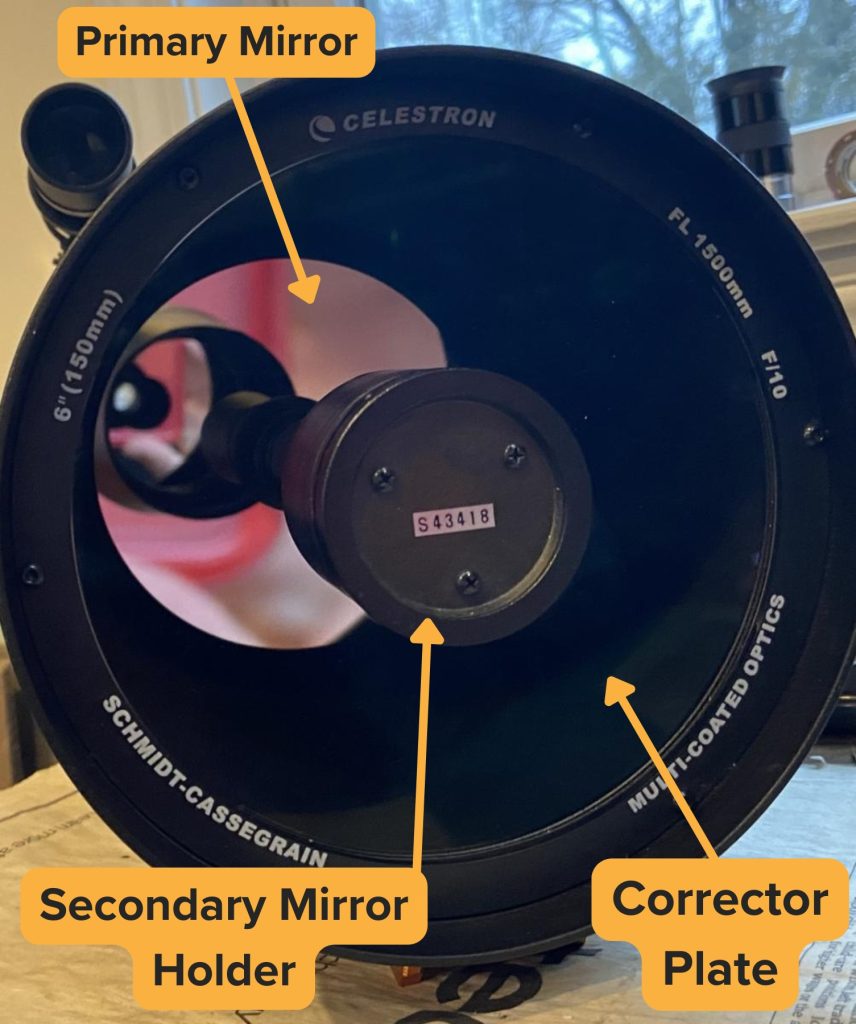
While SCTs have a closed design, their Schmidt corrector plates are relatively thin, allowing for faster thermal acclimation. Unfortunately, the limited ventilation means they’re not immune to thermal issues. A typical Celestron C8 is not a problem on a summer or autumn evening, but taking one of these scopes from room temperature to freezing conditions can mean upwards of an hour of waiting.
The thin correctors in SCTs are made of plate or crown glass, which expands a lot with temperature. Subjecting it to a huge temperature change can shift the telescope’s collimation, as the tube and, more importantly, the metal or plastic secondary mirror holder attached to the center of the corrector are made out of metal, which moves at a different rate. Theoretically, a large enough temperature shift in a short span of time could even crack the corrector.
Celestron’s EdgeHD telescopes do have vents at the back, as did some larger Meade SCTs, but it’s very hard to add ventilation or fans to most of these telescopes without a lot of drilling and tapping of the rear cell.
Maksutov-Cassegrains (MCTs)
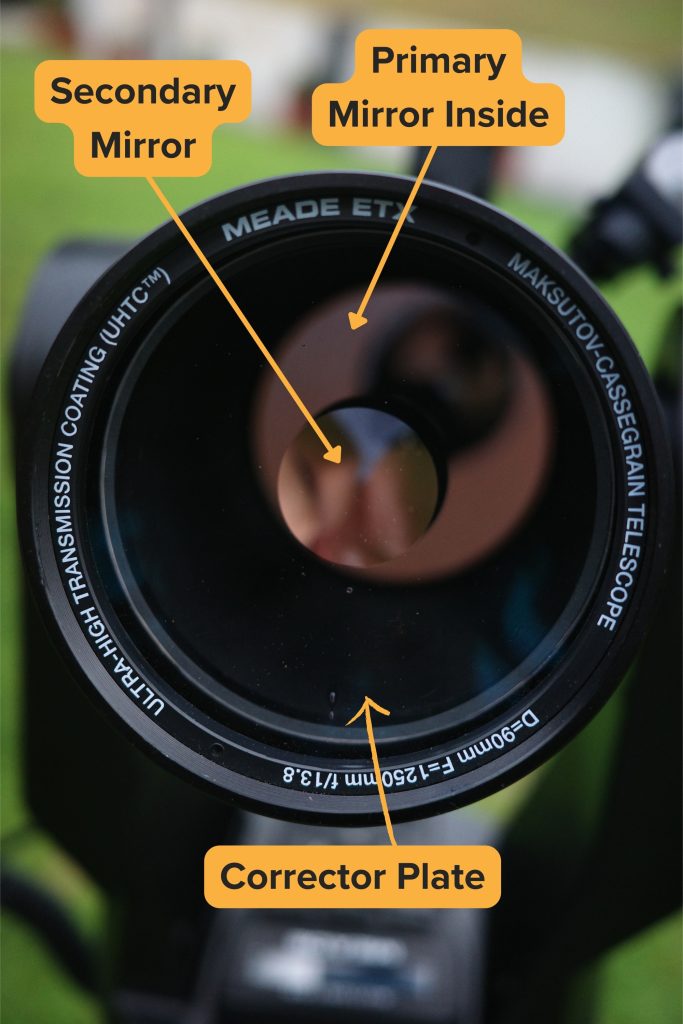
Maks can be particularly tricky in terms of thermals. Their defining Maksutov lens is thick, retaining heat much longer than thinner optics. Combine this with a thick primary mirror and almost no ventilation, and we have what I’d term a “thermal nightmare.” This extended cooldown time can be especially challenging for impromptu stargazing sessions—ironic, considering Maksutovs’ reputation as compact “grab n’ go” telescopes.
Rutten-Maksutov or “Rumak” telescopes with a separate secondary mirror have it worse than their Gregory-Maksutov counterparts since the secondary is now a separate piece of glass with a metal holder attached inside the corrector.
From my own experiences, it’s basically impossible to cool Maksutovs over 5” without adding fans or wrapping the telescope tube in reflective insulation.
Schmidt-Newtonians, Maksutov-Newtonians
Similar to their Cassegrain counterparts, the rare Newtonian versions of these catadioptrics also suffer from the thick corrector’s thermal retention. The corrector also traps the boundary layer radiating off the primary; this can be particularly bad since Maksutov-Newtonians tend to be fairly stubby and commercial units often lack any ventilation behind the primary mirror.
Rare Newtonian reflectors with optical windows in place of the spider, such as the Edmund Astroscan, behave thermally like Schmidt-Newtonians.
Klevtsov-Cassegrains and other designs with a sub-aperture corrector lens (Vixen VMC, etc.)
These are among the most challenging when it comes to thermal management. The design often includes a corrector that obstructs the baffle tube (the main route for air exchange) or impedes the secondary mirror from radiating away its heat. These elements combined can lead to prolonged and uneven cooldowns, severely affecting image quality.
